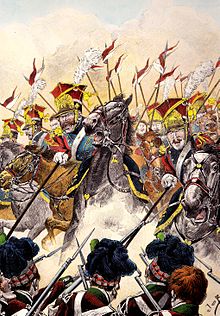2 e régiment de chevau-légers lanciers de la Garde impériale
|
2 e régiment de chevau-légers lanciers de la Garde impériale |
|
|---|---|
 A red Ulan of the Guard (Hippolyte Bellangé, 1843) |
|
| active | 1810 to 1815 |
| Country |
|
| Armed forces |
|
| Armed forces |
|
| Branch of service | Light cavalry |
| Type | regiment |
| Strength | 939-2500 |
| Insinuation | Guard impériale |
| Location | Versailles |
| Nickname | Lanciers rouges (Red Uhlans) |
| commander | |
| Colonel of the regiment |
Pierre David de Colbert-Chabanais |
The 2 e régiment de chevau-légers lanciers de la Garde impériale , also called Lanciers rouges (Red Uhlans) or Écrevisses (Crayfish) because of their completely red uniforms , was a cavalry regiment of Napoleon's Imperial Guard. It was set up in 1810 from the largest part of the regiment "Hussards de la Garde hollandaise". It existed until 1815.
Lineup
In 1810, Napoléon annexed the Kingdom of Holland together with the Hanseatic Departments in order to be able to better enforce the continental blockade against Great Britain. A decree of July 14th announced the official incorporation of the Royal Dutch Guard into the Guard impériale . They formed a brigade with the one he régiment de chevau-légers polonais lanciers
On August 10, the "Régiment de hussards de la Garde royale" (regiment of the hussars of the royal guard) under the command of Colonel Dubois set out for Versailles , where it arrived on August 30. The four Dutch escadrons fraternized with their French comrades and by decree of September 13, 1810, they were converted into a second regiment of Guardians. Général Colbert-Chabanais became the commander .
In 1812 the regiment went into the Russian campaign, where it initially belonged to the vanguard and performed extensive security services for the foraging columns . Then it was combined with the Polish Uhlans into a brigade, which was under the command of Général Colbert-Chabanais. When the regiment arrived in Moscow in October, the combat strength was 556 men. After the fire in Moscow and the battle of Tarutino , the Uhlans formed part of the rearguard that had to cover the French retreat. On October 24th, they rejected a massive attack by the Cossacks on the rearguard, outnumbered. The bad climatic conditions caused great sacrifices among the Uhlans and their horses, at the end of the campaign only 60 riders had a uniform. Rebuilt, they fought in the Battle of Reichenbach on May 23, 1813. In 1814, the Uhlans were involved in fighting during the French retreat on Paris in Belgium.
After the first restoration of the monarchy ( First Restoration ), the red Uhlans were renamed the “Corps royal des chevau-légers lanciers de France”. During the reign of the Hundred Days , they got their old name back. The regiment belonged to the "Brigade de cavalerie légère" (Light Cavalry Brigade) of the Imperial Guard and moved with them to Belgium, where it fought in the Battle of Quatre-Bras and attacked British infantry carées in the Battle of Waterloo . Here it suffered considerable losses. After Napoleon's second abdication, it was dissolved on August 30, 1815.
composition
When it was set up in 1810, the regiment consisted of 939 horsemen in four escadrons of two battalions each. In 1812 a fifth Escadron was set up, which increased the workforce to 1406. In 1813, the "Escadron de dragons de la garde municipale de Paris" was incorporated as a fifth escadron as part of the Garde municipale de Paris, which was dissolved after the Malet conspiracy .
The first four battalions consisted of Dutch and belonged to the old guard, the others consisted of French and belonged to the young guard. The highest number of riders was 2500 riders, which in the restoration as "Corps royal des chevau-légers lanciers de France" dropped 634 men. When Napoleon returned from Elba, he carried the remaining bodyguard cavalry with him, an escadron of the Polish Uhlans, which was incorporated into the regiment of the red Uhlans.
Colonel
- 1811–1815: Pierre David de Colbert-Chabanais
Known members of the regiment
- Antoine Fortuné Brack (1813–1815), later general of the cavalry
- Auguste Louis Petiet : Formerly Lieutenant-Colonel in the 13th Hussar Regiment. He preferred to be named (with the lower rank) " Chef d'escadron in the Lanciers rouges of the Vieille Garde" (Old Guard).
- Jean-Pierre Gauthier , called Leclerc as Major, later Général de brigade
literature
- Ronald Pawly & Patrice Courcelle "Napoleon's Red Lancers" Editeur Osprey Publishing Collection Osprey Série: Men-at-Arms N ° 389 2003 ISBN 1-84176-508-2 .

